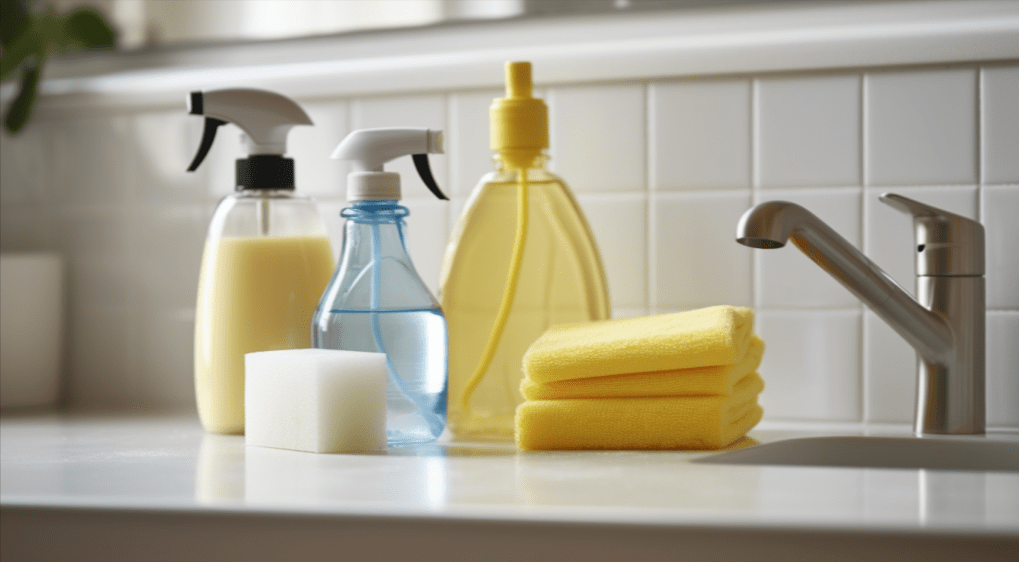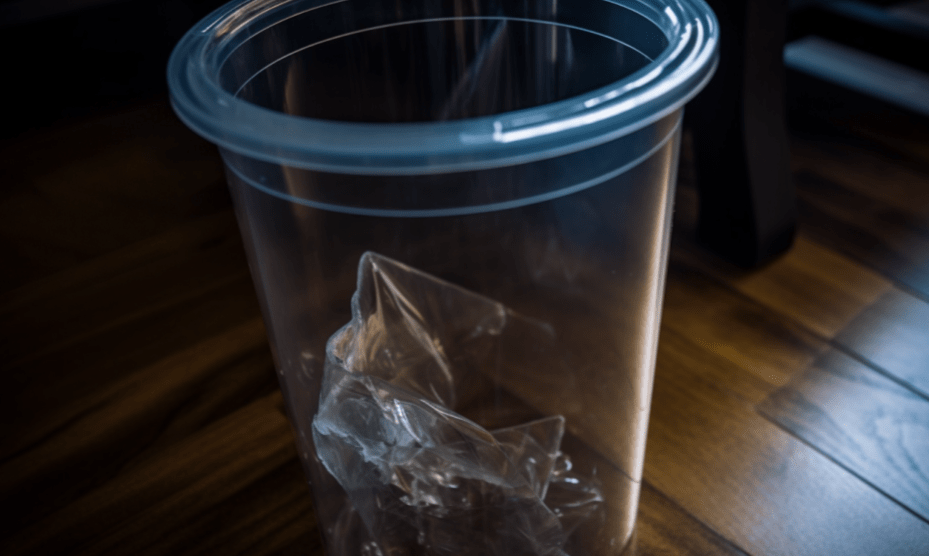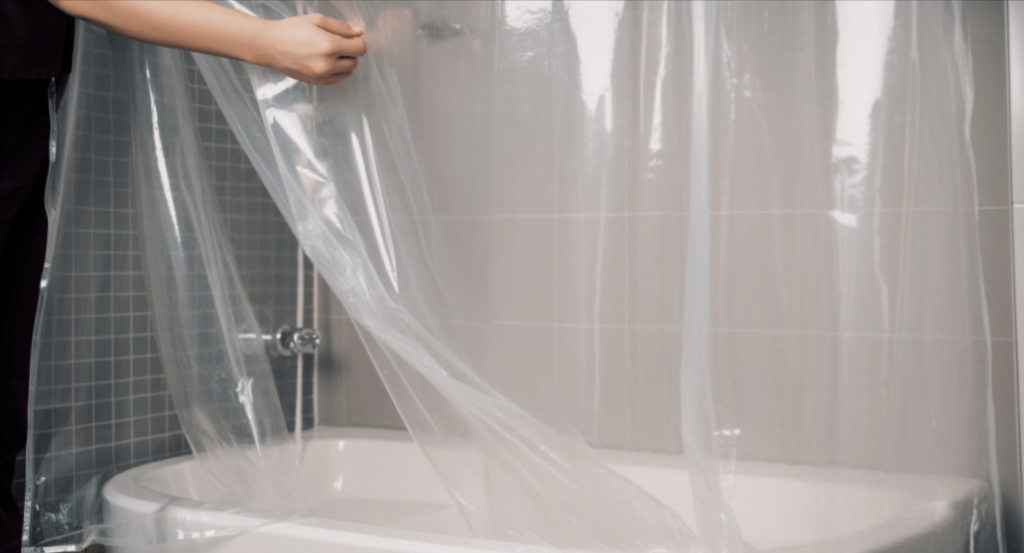PEVA Material
PEVA is a type of vinyl, specifically Polyethylene Vinyl Acetate, which is non-chlorinated. This means it is made without chlorine, which is usually used in the production of PVC (Polyvinyl Chloride). This difference in manufacturing processes results in a material that’s less harmful to the environment and to human health. The absence of chlorine is an advantage as it prevents the release of harmful dioxins.
PEVA, as a material, is flexible, waterproof, and durable, making it a suitable material for a variety of applications, one of which is shower curtains. It has a softer and smoother feel compared to PVC and its counterparts. The suppleness of PEVA offers a better drape compared to stiffer PVC shower curtains, contributing to a more luxurious look and feel.
However, PEVA is still a type of plastic. Therefore, while it is a better option than PVC, it is not the most environmentally friendly material available. It’s derived from non-renewable resources like oil and natural gas, and is not biodegradable.
| Factor | PEVA | PVC |
|---|---|---|
| Chemical Composition | Non-chlorinated | Chlorinated |
| Production | Does not involve use of chlorine gas | Uses chlorine gas which can be harmful if released |
| Release of Harmful Chemicals | Does not release dioxins, phthalates, or VOCs | Can release dioxins, phthalates, and VOCs |
| Material Feel | Soft and flexible | Can be stiff and less flexible |
| Environmental Impact | Derived from non-renewable resources but less harmful than PVC | Derived from non-renewable resources and potentially more harmful due to release of dioxins |
| Disposal | Not widely accepted for recycling and is non-biodegradable | Not widely accepted for recycling and is non-biodegradable |
Environmental Impact of PEVA Shower Curtains
There are a lot of “green” misconceptions about PEVA curtains, so let’s clear some of those up. While PEVA shower curtains are a safer choice for indoor environments due to the absence of harmful chemicals, it’s important to remember that PEVA is still a plastic and thus comes with environmental concerns. PEVA, like other plastics, is derived from non-renewable resources such as oil and natural gas. The extraction and refining of these resources contribute to environmental degradation and climate change.
Additionally, even though PEVA is less harmful than PVC, it is not biodegradable. This means that at the end of their lifespan, PEVA shower curtains do not break down naturally in the environment, which can contribute to plastic pollution. They can also pose a threat to wildlife, particularly if they enter marine ecosystems.
The disposal of PEVA shower curtains is another significant environmental consideration. Although PEVA is recyclable in theory, not all recycling facilities accept this type of plastic. As a result, many PEVA shower curtains end up in landfills where they may take hundreds of years to decompose, leading to long-term environmental impact. Just make sure to research local recycling options when disposing of a PEVA shower curtain.
Care and Maintenance of PEVA Shower Curtains

Maintaining PEVA shower curtains is relatively straightforward due to their waterproof nature. A simple wipe-down with a damp cloth is usually sufficient to keep them clean. For stubborn stains, a gentle cleaning solution can be used. Be sure to avoid harsh chemicals that could damage the material and cause it to break down prematurely.
Additionally, many PEVA shower curtains are machine-washable. If you choose to machine-wash your curtain, use a gentle cycle and cold water to avoid damaging the material. It’s also best to let it air dry rather than using a dryer, as the heat can warp or melt the plastic. Always check the specific care instructions on your curtain, as these may vary between manufacturers.
Proper care also involves being mindful of mildew and mold. While PEVA is resistant to these, regular cleaning is necessary to prevent buildup. It’s also advisable to pull the curtain fully closed after each shower to allow it to dry completely. Doing so will help prevent mildew and extend the curtain’s lifespan.
Durability of PEVA Shower Curtains
PEVA shower curtains are known for their durability. Their inherent flexibility means they’re less prone to tearing than other types of shower curtains. This flexibility, coupled with their waterproof nature, allows them to withstand daily wear and tear exceptionally well, making them a practical choice for families, rental properties, or anyone looking for a long-lasting solution.
However, the lifespan of a PEVA shower curtain can be greatly affected by how it’s cared for. Regular cleaning, careful handling, and proper drying can significantly extend the curtain’s life. It’s also important to avoid sharp objects that could potentially rip the curtain.
Despite their durability, PEVA shower curtains will eventually show signs of wear and need replacing. Common signs include color fading, increased stiffness, or the formation of tears. When this occurs, remember to consider environmentally-friendly disposal methods such as recycling, if available in your area.
Transparency and Design of PEVA Shower Curtains
PEVA shower curtains offer a lot of versatility when it comes to design. They can be manufactured to be either transparent or opaque. Transparent or semi-transparent curtains allow for more light to pass through, creating a more open and airy feel in the bathroom. They can be useful in smaller bathrooms where natural light is limited.
Beyond transparency, PEVA shower curtains come in a wide variety of colors, patterns, and designs. You can find anything from simple, minimalist designs to intricate, artistic patterns. This range of options makes it easy to find a curtain that matches your bathroom decor and personal style. Some manufacturers even offer the option to custom-design your PEVA shower curtain, allowing for even greater personalization.
Although PEVA curtains offer a wide range of design options, they may not have the same luxurious feel as fabric curtains. However, they are an excellent choice for practicality and ease of maintenance, making them a popular choice for many households.
Cost of PEVA Shower Curtains
PEVA shower curtains are generally affordable, making them an accessible choice for most budgets. The cost can vary based on a few factors, including size, design, and brand. Plain, simpler designs tend to be cheaper, while more intricate patterns or custom designs can be more expensive.
Even though PEVA shower curtains might be slightly more costly than their PVC counterparts, many consumers consider the price difference a worthwhile investment for the health and environmental benefits that PEVA offers. The durability of PEVA also means the curtain might last longer, potentially saving money in the long run.
However, when considering the cost, it’s worth bearing in mind that cheaper isn’t always better. Lower-priced curtains may not be as durable or as safe as slightly pricier ones. It’s essential to research and read reviews before making a decision to ensure you’re getting a good-quality product.
Disposal of PEVA Shower Curtains

The disposal of PEVA shower curtains is a crucial consideration when assessing their environmental impact. Ideally, at the end of their lifespan, these curtains should be recycled rather than discarded in regular trash. However, not all recycling facilities can process PEVA, which can make proper disposal challenging.
Before discarding a used PEVA shower curtain, it’s worth researching local recycling programs to see if they accept this type of plastic. Some areas may have specific recycling programs for plastics that are not commonly accepted in curbside recycling.
If recycling isn’t an option, consider reusing the curtain in some way. For example, it could be used as a drop cloth for painting, a liner for a pet area, or even cut into smaller pieces for use as reusable shopping bags. These options can extend the curtain’s life and reduce the environmental impact of its disposal.
Alternatives to PEVA
If you’re looking for a more environmentally friendly option than PEVA, consider shower curtains made from natural materials like organic cotton or hemp. These materials are renewable, biodegradable, and don’t release harmful chemicals into your home or the environment.
Cotton and hemp curtains can be treated to be water-resistant, but they may not be as inherently waterproof as PEVA or PVC curtains. Therefore, they may require more frequent washing or replacement. However, these natural alternatives can be composted at the end of their lives, reducing waste.
Another option is recycled PET plastic, often made from recycled water bottles. While still a type of plastic, these curtains can be recycled again at the end of their lives, contributing to a circular economy.

Colby Armstrong
Colby Armstrong, born and raised in Vermont, is an inventive designer who developed a fascination for interior design and color coordination from a young age, influenced by his home decorator parents. An ardent hiker and nature enthusiast, Armstrong draws inspiration from natural elements and colors, incorporating them into his unique shower curtain designs.

